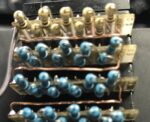Cost-effective Homebrew Resistance Decade Box
 A resistance decade box, sometimes called a resistance substitution box is used mainly for creating a known temporary resistance in an electronic circuit.
A resistance decade box, sometimes called a resistance substitution box is used mainly for creating a known temporary resistance in an electronic circuit.
A decade box is nothing more than a series of precision, or if you prefer, extremely close tolerance resistors connected by switches in such a way that it is possible to select the resistance value you require.
Some decade boxes are arranged in such a fashion that only the “preferred” values of resistance can be selected. Others, like my homebrew one here, allow any resistance up to the total available resistance to be selected.
A schematic diagram of my resistance decade box in PDF format can be downloaded here.
 As a starting block for the project, I obtained thumbwheel switches, the switches used are simple single pole, 10 way with no encoding.
As a starting block for the project, I obtained thumbwheel switches, the switches used are simple single pole, 10 way with no encoding.
It must be noted that these thumbwheels are also available with BCD encoded outputs, which are not suitable for this purpose.
The individual wafers simply sit side by side and as many wafers as required can be used. The wafers may only be assembled correctly as they are “keyed”. Thin threaded rods with suitable nuts at each end hold the complete assembly together along with end the pieces to form a single unit.
Laboratory grade resistance decade boxes are extremely expensive, however they are designed and built to exacting standards and tolerances which make them extremely accurate over their entire range of values.
For my purposes, the resistance decade box I built was constructed using conventional, and readily available, metal film resistors that I had in my components boxes. The resistors I used have a 1% tolerance which for low values up to a few KΩ isn’t a great concern for hobby use. Obviously, the larger the main value, the greater the margin of error of the resistors overall value.
 Each wafer holds nine resistors of the same value connected between the contacts on the thumbwheel so that each number position has the same amount of resistors inline, eg: position 4 on the thumbwheel has 4 resistors in series, position 8 has 8 etc.
Each wafer holds nine resistors of the same value connected between the contacts on the thumbwheel so that each number position has the same amount of resistors inline, eg: position 4 on the thumbwheel has 4 resistors in series, position 8 has 8 etc.
Position 0 of each thumbwheel is connected to the common contact of the previous thumbwheel, except for the 0-9Ω thumbwheel (far right side) which is connected to one of the front panel sockets with the common of the highest value thumbwheel (leftmost) is connected to the other front panel socket.
When in use, it’s a simple matter of reading the displayed number to give a fairly close value of total resistance across the front terminals.
In summary, not as accurate as a lab grade resistance decade box, but at much less than a tenth the cost, it works for me.